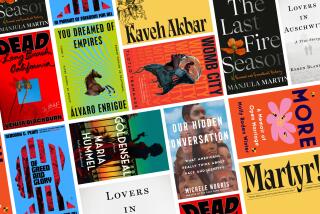DISCOVERIES
- Share via
-----
The Last of Her Kind
A Novel
Sigrid Nunez
Farrar, Straus & Giroux: 376 pp., $25
“I believe you have to reach a certain age before you understand how much life really is like a novel, with patterns and leitmotifs and turning points, and guns that must go off and people who must return before the ending,” says the narrator of Sigrid Nunez’s densely woven novel of the 1960s and ‘70s. Georgette George, a daughter of the upstate New York working class, meets her roommate, Ann Drayton, privileged daughter of the Connecticut bourgeoisie, on their first night at Barnard. It is 1968; violence is everywhere, in Vietnam, on the streets, in Georgie’s home (where her mother beats Georgie and her siblings until her younger sister Solange runs away), and in Ann’s hatred for her parents and almost anyone white and wealthy. (“For Ann, only the poor had rights; the rest had obligations.”)
Georgie leaves college shortly after being raped in Central Park. She gets a job at a fashion magazine. Ann falls in love with a black man named Kwame. Many years and a few marriages later, Georgie learns that Ann has shot and killed a policeman who threatened Kwame. Now the novel, already a burgeoning plant sending out shoots (that usually end in men), begins to branch uncontrollably: Solange reenters Georgie’s life, Georgie falls in love with Ann’s widowed father; a final section is narrated by Ann’s fellow inmate. But such questions as what it means to be American, whether hate and rage are useful tools and whether we can correct mistakes of previous generations engage us throughout.
-----
Wide Eyed
Stories
Trinie Dalton
Akashic Books: 170 pp., $13.95 paper
LET’S play a game: If I say “avocado,” “tequila,” “Craftsman house,” “feminist doughnut shop,” what L.A. neighborhood comes to mind? Right! Echo Park. Trinie Dalton, speaking in the voice of a child bathing her hamster in a teapot, imagining a correspondence between an elf and a human (“Dear Elf, You are so distinguished looking!”) or realizing that a hummingbird she’s been feeding is giving her the evil eye, causing numerous small injuries, confers on her readers a childlike willingness to see the world her way. You feel oddly happy reading her quirky stories, as if you’d wandered into a bar where people talk in a lazy, friendly way. “The Summer of Ailments sucked,” begins one story. And: “I can’t wait until springtime,” muses Snow White, in her coffin, “so the glass won’t fog up where I breathe.” And: “A haggard man eating Flamin’ Hot Cheetos leaned against the hot dog display.” If fiction were a giant transporter, I’d want to go to Trinie Dalton’s world.
-----
Oh What a Slaughter
Massacres in the American West: 1846-1890
Larry McMurtry
Simon & Schuster: 192 pp., $25
“THE image of a meat shop seems apt to me,” writes Larry McMurtry of the six massacres described here, “since what massacres usually do is reduce human beings to the condition of meat, though the bits of meat will be less tidily arranged than the cuts would normally be in a decent butcher shop.” This final clause conveys the tone of his strange little book: an effort, perhaps, to look dispassionately, scientifically, at these horrific episodes. The lingering “taint” fascinates him -- the image, for example, of Mormon elder Nephi Johnson, a participant in the Mountain Meadows Massacre of 1857, crying, “Blood, blood, blood!” as he lay dying. In scrutinizing Mountain Meadows, the Sand Creek Massacre, the Sacramento River Massacre, the Marias River Massacre, the Camp Grant Massacre and the Battle of Wounded Knee, he tries to comprehend what leads men to kill not just one another but also women and children. (“The resilience of babies ... has been noted in many such contexts.”) He is particularly interested in fear and the frenzy it produces, followed by distaste and regret. The more we read of such accounts, the better we will understand the West’s history and “the bloody work that taking it required.”
More to Read
Sign up for our Book Club newsletter
Get the latest news, events and more from the Los Angeles Times Book Club, and help us get L.A. reading and talking.
You may occasionally receive promotional content from the Los Angeles Times.







